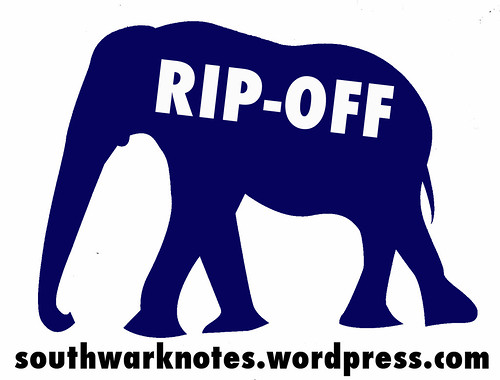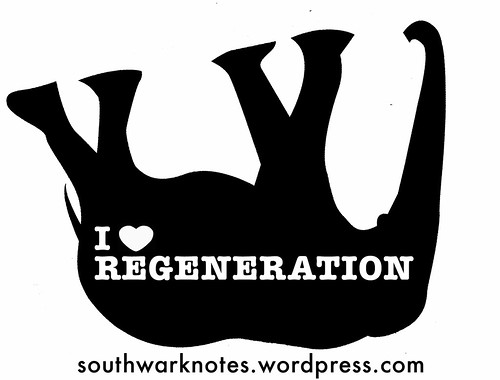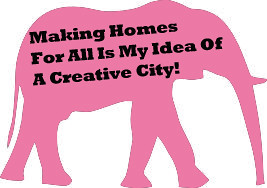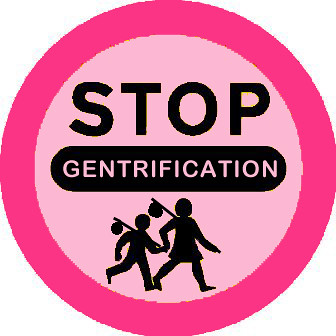(NB: This was written probably in 2007 and edited in 2010. It’s a basic statement on the changes and is useful to see where we were coming from then, what we thought was happening and how we were mostly right. )
Whose Regeneration?
Over the last few years, a lot of new residential housing has been put up in the newly attractive London Borough of Southwark. It started with luxury lofts and apartments being built in the new supposed ‘cultural quarter’ of Bankside where the Tate Modern and Globe Theatre had arrived in the 1990’s. The next area to be ‘up and coming’ was The Borough, where the trendy foodie Borough Market brought in pioneer homebuyers and developers. After the luxury flats market set the trend for our previously unfashionable and always snubbed part of London, the volume housing developers (like Wimpey or Countryside) came in on the act to throw up acres of cheaply built but expensive housing. Now, after, nearly a decade of development, Walworth, one of the poorest areas in England has seen the first arrival of a yuppie housing market. Not only has this impacted on the local area, with vacant spaces being built on for new oddly-coloured buildings, but the sale and market in ex-council houses has gone through the roof: £270,000 for a flat on The Pullens Estate (at it’s peak June 2007).
Who Benefits?
The high prices are maintained by the forthcoming myth or reality of the massive ‘regeneration’ of the Elephant and Castle area. These slow moving plans seek to knock down the Shopping Centre and the Heygate Estate and replace it with a mega complex of hotels, retail developments and hundreds of new expensive private houses and blocks. Along the way, a required percentage of social ‘affordable’ housing will be factored in. The theory is that the private developments make enough profits out of the Elephant Area to kick back some down to the local community in the form of social ‘affordable‘ housing and paying for a few tiny parks or leisure facilities. What private companies want is access to the high land values and property prices that can be found in North Southwark because of it’s close proximty to The City and West End. They also want to build expensive flats for richer people who now are happy to live South for precisely the above reason. Somehow we doubt these people will want to gad about Walworth Rd drinking in Temple Bar (er..now a Poundland!) and having a meal in Cafe Time. So they will either shop and entertain themselves elsewhere or they will expect major changes in the shops and services of the local area instead (as is happening in parts of The Borough and Bermondsey where you can buy a loaf of bread for £3 should you wish).


Caff on Walworth Rd / Borough Market – Pheasants, Geese, Duck and Partridge for sale
Essentially, what is planned for The Elephant then is to change the local character of the area from one of poor people and the type of shops and services poor people use and rely on to a landscape and culture of more well-off people and the mega shops and service industries they require. It’s obvious to us that without this change in the local population, no big business will want to invest their money in big shops, hotels and private leisure facilities in The Elephant because poor people won’t be spending any money in them. This kind of social engineering can be seen when Councillor Nick Stanton (Leader of The Council) talks* of the area becoming a retail centre like ‘Bath or Chester’, two areas not well-known for their poverty! He also talks of wanting to attract shops such as Waitrose and John Lewis! Mr Stanton doesn’t seem to understand that most local people are not crying out for these shops because even if they were here we couldn’t afford what they sell anyway.
* (Talk at Walworth Community Council meeting Feb 2010)



Chester / Bath / Wally Rd 😎
What Do We Mean By Gentrification?
‘Gentrification is the name given to the process by which the original working class inhabitants of an area are displaced and the whole social character of the neighbourhood is changed. The ‘gentry’ are members of the middle classes: professionnals and managerial people’. From ‘Housing for People or Profit?” by John Cowley, (1979), one of the best books on the politics of housing.
One of the important points to remember about gentrification is that not only are local people displaced from the area by the decants, demolitions and rising property and retail prices, but other people from similar backgrounds and income levels are also prevented from moving to the area.
• URBAN PIONEERS RIDE INTO TOWN?
New buyers into the posher private housing (like Metro Central Heights), often portrayed as ‘the pioneers’, are sometimes a little bit guilty of making out that they are ‘opening up’ a new part of London as if thousands of people already living in the area have not had their own organic fabric of a community. It seems like the thousands of poor people in poor housing that sits cheek-by-jowl to redevelopment zones are often made invisible in the new shiny plans. This kind of forced invisibility is particularly strong around The Elephant but even stronger around the ridiculous makeover of Bermondsey St into a consumer-driven new playground for the more affluent newcomers. The Telegraph article ‘Property Investment? Time to pack your trunk?’ from November 2007 sums up this mentality – ‘One of London’s unloveliest areas has become its newest hotspot, with investors snapping up off-plan opportunities…ugly old concrete buildings coming down and gleaming new ones going up…’. Estate agent Carl Davenport is quoted ‘The E+C may not look like much now but it is an area on the move which means it’s the right time to invest. Once all the new buildings start to appear it will be too late and buyers will have missed the boat’. Is the ‘regeneration’ of the area then simply a place to invest and profit from an over-inflated housing market or is it a scheme to develop renewal for all of the local population, old and new? First rung flats on the property ladder, Buy-To-Lets, corporate rentals – none of these add anything to the already existing community. In fact, in places they can make it worse as the temporary tenants are often ignorant, arrogant or inconsiderate about the older local inhabitants. This isn’t to say that all newcomers to the area are like this or, in fact, that all the poorer old-timers are angels. It’s just worth pointing out that the ideology of supposed mixed-development often assumes council housing as the bad with the new private houses and new shops as the good. However, people with hardly any money relate to the local area in a totally different way to those who money is often no worry.
None of this denies that where we have lived for a long time isn’t perfect. Far from it, it’s often harsh and sometimes unrelenting but at least it’s somewhere that’s been lived and grown according to the more simple needs of people and not pure individual or corporate profit. Community is not something you can consume, it’s something more common, organic and human than that.
MOVING BACK SOUTH! Recent times, ‘localism’ and money! The social fabric of where we live and…Empire Square.
What’s interesting to us is how after the double whammy of post-war displacement from local people being moved out to new estates in Essex and Kent and the loss of housing from the 1970’s office buildings, the late 90’s suddenly saw a whole move of people who wanted to live in the North Southwark area because it was close to both jobs and recreations in the City and the West End. Although many local people have lived in this area for a very long time on large council estates (like Tabard), the new wave of people wanting to live in the area were less likely to have any local roots. Although there is much to be said about how the newer arrivals can be oblivious and sometimes arrogant to these older (and, of course, poorer) residents, we also are wary of what we term ‘localism’. By this we mean a simplistic perspective that pits old against new merely in terms of who has lived longer in an area. We make our arguments based on many things. Two of the most pertinent are these:
(1)
Older local communities have as much right to a say in what goes on in the area where they live. This means that the pursuit of profit is usually against the interests of those who will suffer the loss of amenity, rising houses prices, possible displacement etc. It seems to be the case that the Council and developers stick to the old ridiculous and anti-human adage that ‘you can’t stand in the way of progress‘. In modern terms, this means that new developments take precedence over older human wants and needs as they supposedly bring benefits to all. This is obviously daft and untrue and taking a walk around some of the new developments written about below will demonstrate quite clearly that we will not benefit one jot from more and more luxury flats. It seems only fair that we have a say on what is planned and built where we live. This would be to demand our right to the city too! It also seems fair that together we can also maintain the less obvious aspects of our communal life that are always priceless and impossible to put a value on. Hence our next point…
(2)
If we subordinate every single part of our life to the sainted economy we will eventually live in a soulless area where everything is about consuming and nothing is about the daily fabric of what makes a real community function – that would be street life, libraries, pubs, place for ‘doing nothing’ in, local cafes, open spaces, local markets, playgrounds and so. As we see it, these places are first and foremost where a community exists around each other and enjoys that social life. Although in some of these spaces we might spend a few quid on a beer or a tea or some egg and chips, primarily these spaces are not about the spending of money just for something to do. It’s true that new developments often factor in some kind of public space such as little green space with benches but in the main these space tend towards anonymity and sterility. If you contrast some of the architectural drawings that you see on the hoardings of development sites with the reality afterwards, you tend to find that these new ‘public’ spaces are either privatised at night when the development gates are firmly put in place OR despite the concrete benches, lit-up trees and snazzy blue lights in the pavement, no-one feels like hanging out there because they feel like urban morgues policed by zealous security guards with a list of no-no’s for the newly privately owned space like More London at Tower Bridge. Empire Sq is a great example of this dead new ‘public’ space!
THIS IS WHAT GENTRIFICATION LOOKS LIKE
Bermondsey 2010 onwards…
For us it was unimaginable that Bermondsey could be gentrified. Here is the bastion of an older working-class series of communities in numerous council estates. The local area was run down but full of mini-shopping areas (Abbey St, Dockhead etc) serving the local population. Jump to 2011 and the third White Cube super fancy art gallery (Eton-educated owner Jay Jopling, son of Baron Jopling, no less) has opened on Bermondsey St huddling close to a Tapas and Sherry Bar! There has always been a smattering of the artistic goings-on around Bermondsey since the 1970’s beginning at Butlers Wharf and slowly nestling itself in the area, cheek by jowl, as it were. But this older activity was taking advantage of the post-docks cheap rents / large warehouses to be had. By 1979, they were all turfed out for Terence Conran’s redevelopment of those buildings into flats and restaurants. White Cube arrives in Bermondsey St as a legacy of that redevelopment.
Bermondsey St is a fun-packed article from Time Out in 2004 just as the gntrification was really getting going. We particularly like these phrases and sentences: “developed from drug-dealing hellhole to model of inner-city regeneration”, “was a grim wasteland of drug dealers and dodgy pubs”, “trendy but friendly lofters regularly rub shoulders with tenants from the local authority blocks. And everyone gets along just fine”, “nobody really wants a Sainsbury’s”, “just to show the area hasn’t completely given itself over to ciabatta and cappucci- nos, this old-school pie-and-mash shop attracts lunchtime queues of local business workers, sitemen from building works”, “professional couples are filling up new-build flats and paying between £300,000 and £350,000 for a two- bedroom, two-bathroom flat”…and they say class is dead!
Here’s a quote on Bermondsey from The Standard (June 2011):
‘B is for Bermondsey
Sure, you can eat an avant-garde supper in a candlelit warehouse in East London, but if you want to be right on the cutting edge, head to Bermondsey Street, SE1, (soon to be known as Bermz) and its adjacent roads. Zucca (Italian), Magdalene (French), The Garrison gastropub and sister restaurant Village East (British) have all been quietly keeping the locals well fed in recent years, but the area has just reached a tipping point with the arrival of José, a charming new tapas restaurant from José Pizarro (ex-founding chef of Gwyneth Paltrow’s and Nick Clegg’s favourite Brindisa). ‘It’s a vibrant area – full of fantastic restaurants and food havens,’ says Pizarro. ‘I’ve chosen Bermondsey Street because this is where London feels at its buzziest – I want to be part of that!’ What’s more, locals insist the food market at nearby Maltby Street is even better than Borough’s (where some traders are angry about rising rents and pitch evictions). White Cube‘s newest gallery will add cultural clout when it opens on Bermondsey Street (it just got planning permission). As White Cube’s director of exhibitions, Tim Marlow, puts it, ‘It’s an extraordinarily interesting, culturally growing part of London.’ The inevitable downside is that, as with all hip districts, soon everything will be wildly expensive. Gordon Ramsay is opening the Union Street Café nearby next year, and the Shard will have three floors of huge super-swanky restaurants (on levels 31, 32 and 33, with a three-storey atrium linking them all) – as yet, the details of all these openings remain under wraps.’
Does the above explain it well enough?
And now this in The Guardian: Let’s Move to Bermondsey (Jan 2012). Their summary for the area is that “The Case For” is all that foodie stuff tucked away in little arches and specialist shops is great BUT all that poverty nearby makes you feel a bit queasy after ya quail egg and Tuscan tripe ciabatta. Well, we are reading between the lines: ‘The case against A tale of two cities: it’s either hyper-gentrified or hyper-ungentrified, and never the twain shall meet. This makes for a peculiar patch of city where poverty and affluence jar’.


Maltby St, the foodie haven that punters like to think about as their ‘little secret’ now that Borough Market is full of plebs and tourists, is expanding eastwards into what could be considered some times when we lived there a no-go zone for outsiders. Oh how time’s have changed! Now it’s all Food Porn and the resultant overprices orgasms that accompany a breeze round all the artisan and bespoke foodie merchants. Will it colonise the railway arches as far down as Ilderton Rd and The Den?
Although estate agents and developers would have never used the term ‘gentrification’ in the period 1980’s – 2000’s because of its obvious social cleansing aspect, it now seems that it’s okay to use this term in ads, promotional brochures and websites. Below we quote from the website Property Investing informing potential investors about where to buy in London:
- ‘Gentrification of areas like Limehouse, Shoreditch, South Hackney, Whitechapel
- Improvements from a low base in Peckham, Hackney, New Cross, Brockley, Forest Hill
- Elephant & Castle, Lambeth and Kennington – close to City and West End jobs and wealth’
You can see here from the terminology and descriptions that they use that what is explicit is the truth about gentrification – that it’s all about richer people moving into traditionally poorer areas. Here’s their Property Investment hotspots map:
You can see that The Elephant is designated as an ‘ultra hotspot’. This might explain why lots of overseas investors in property from China and Hong Kong are buying into the new developments in North Southwark. It’s not to live in our sunny and warm area but purely to use the globalised property markets to make a load of money from rents, and property values when they sell on.
————————————————————————————————–
Wanna buy a flat in The Elephant? Our guide to the estate agent lingo…
Thinking of moving to the area? The more cynical wing of Southwark Notes has furnished us with this handy cut out ‘n’ keep translation of developer and estate agent brochure-speak.
‘VILLAGE’ – You’re surrounded by council estates on all sides.
‘NEW BUILD’ – The walls are paper thin.
‘BUZZY’ – There’s three lanes of traffic below your windowsill.
‘DIVERSE’ – People who aren’t middle-class and white live there.

CREATIVE – The artists who attracted you to the area are about to be priced out – by you.
‘EXCITING’ – Someone’s gonna have your iPhone in five minutes.
‘DYNAMIC‘ – There’s a small nightclub and two Chicken Cottages.
‘UNIQUE’ – It’s just like the other posh rabbit hutch over the road.

‘CONTEMPORARY’ – A kid with some Lego could have designed it.
‘REAL’ – There’s a big white working-class population.
‘VIBRANT’ – There’s a big Carribean population.
‘EXOTIC’ – There’s a big African population.

‘CULTURAL’ – The Imperial War Museum is up the road.
‘ICONIC’ – The buidling is lop-sided or shaped like a vegetable.
‘SUSTAINABLE’ – The architect has some put some wood on the front.
‘STUNNING’ – Expensive.

‘OASIS’ – You’re living behind huge security gates.
‘URBAN’ – It’s in London, duh!
‘EXCLUSIVE’ – You will drive to and from home so don’t have to interact locally.
‘QUARTER‘ – Basically, you’re living in a yuppiedrome.
*-) As humourists we won’t be giving up our day jobs just quite yet. We do welcome contributions to our handy guide. Pass on ‘em.






















